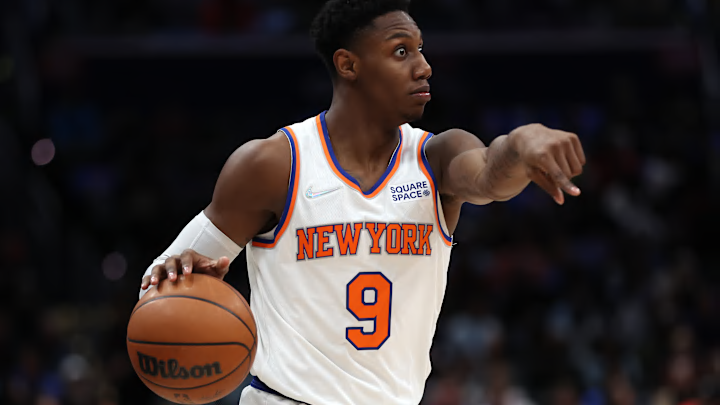How does RJ Barrett’s contract stack up?
The RJ Barrett extension remains a slight mystery, and the devil will be in the details. The language used in reporting has said, “the deal could be worth up to $120 million.” Until we know exactly how Barrett can reach $120 million, it will be difficult to assess fully. However, let’s assume that while reaching $120 million may be difficult for Barrett, it’s not unreasonable to believe that hitting $100 million over the four-year deal is around the baseline. With the cap expected to grow significantly over the course of the contract, $25 million per season could be the going price of an NBA quality starter by its conclusion.
Now, let’s look at comparable players who signed deals that will pay them an average of between $25 million and $30 million next season.
Lowest to Highest
Nikola Vucevic ($25M), Anfernee Simons, John Collins, Jalen Brunson, Jaren Jackson Jr., Jaylen Brown, Al Horford, DeMar DeRozan, Kyle Lowry, Julius Randle, D’Angelo Russell, Joel Embiid, Andrew Wiggins, Nikola Jokic, Gordon Hayward, Chris Paul, Kevin Love ($30.1M)
Of the 17 players in the group, they averaged a 2.56 BPM and a 2.54 offensive BPM in the season prior to signing their extension and a career average of 1.7 BPM and offensive BPM of 1.51. Barrett posted a -1.6 BPM and -0.3 offensive BPM last season and has a career BPM of -2.2 and offensive BPM of -1.2. This sample includes Nikola Jokic and Joel Embiid, who morphed into MVP candidates after signing their extension, and a host of highly established veterans, which muddies the comparison a bit.
The best comps for Barrett are Anfernee Simons, John Collins, Jaren Jackson Jr., Jaylen Brown, D’Angelo Russell, and Andrew Wiggins, who all signed extensions or as free agents following their rookie contracts. This younger and less heralded group produced a 0.08 BPM and a 1.36 offensive BPM in the season prior to signing their extension and a career -0.58 BPM and offensive BPM of -0.15. While Barrett looks more at home here, he is also clearly well below their level.
Comparing Barrett to players currently earning $30 million to $25 million is a slightly disingenuous venture. In a salary cap league like the NBA, a player’s yearly salary is far a less important number than how much of the cap it takes up. Because Barrett’s extension won’t kick in until after this season, and the salary cap is projected to rise significantly, players currently making between $25 million to $20 million are a better comparison. However, even when we expand to players set to earn between $25 million and $20 million, it still doesn’t help Barrett’s case.
Highest to Lowest
Draymond Green ($24.9M), Terry Rozier, Buddy Hield, Mikal Bridges, Mike Conley, Aaron Gordon, Malcolm Brogdon, Harrison Barnes, Fred VanVleet, Jerami Grant, Myles Turner, Lonzo Ball, Jarrett Allen ($20M)
Unsurprisingly, this group produced lower BPMs than the higher-paid group, averaging a 1.45 BPM and 1.3 offensive BPM in the season before signing their extension and a 0.77 BPM and 0.38 offensive BPM in their career. Once again, a few veterans don’t fit Barrett’s age/experience profile. When we remove them we find a far better peer group.
Looking at Buddy Hield, Mikal Bridges, Harrison Barnes, Fred VanVleet, Myles Turner, Lonzo Ball, and Jarrett Allen, we have a group of players earning between $20 million to $25 million on their second contract. In their final season before signing their contract, they averaged a 1.33 BPM and 1.3 offensive BPM, and a 0.58 BPM and 0.25 offensive BPM in their career.
There’s really no other conclusion one can reach; RJ Barrett’s contract is an outlier in terms of value compared to production. He was dramatically worse in the season leading up to his extension and throughout his career than players earning comparable amounts of money.
The difference in BPM between Barrett’s final pre-extension season and the group of $20 million to $25 million earners on their second contract was 2.98. A 2.98 BPM would have been the 32nd best mark in the entire league. The difference in offensive BPM of 1.6 is significantly smaller, but that was 2021-22 Sixth Man of the Year Tyler Herro’s offensive BPM.
RJ Barrett and the Knicks are finalizing a 4-year rookie extension worth up to $120M 🚨
— Overtime (@overtime) August 30, 2022
(per @wojespn, via @NBCSCeltics)pic.twitter.com/TYETRxa709
The Knicks are clearly banking on Barrett making massive improvements over the life of this contract. That hope isn’t completely unreasonable. He was the third overall pick behind two players who are superstar talents in Zion Williamson and Ja Morant, but he’s being paid like a borderline All-Star.
Unfortunately, he hasn’t yet shown that level of ability. There’s a chance he does live up to the contract, but the reality is that the market wouldn’t have handed Barrett a four-year $120 million deal.
Over the past few seasons, the Knicks have quietly structured contracts where the sticker price doesn’t match the true financial commitments. If that’s the case, this could have been a fair piece of business, but without the details, it looks like the Knicks are more likely than not to end up with buyer's remorse.
